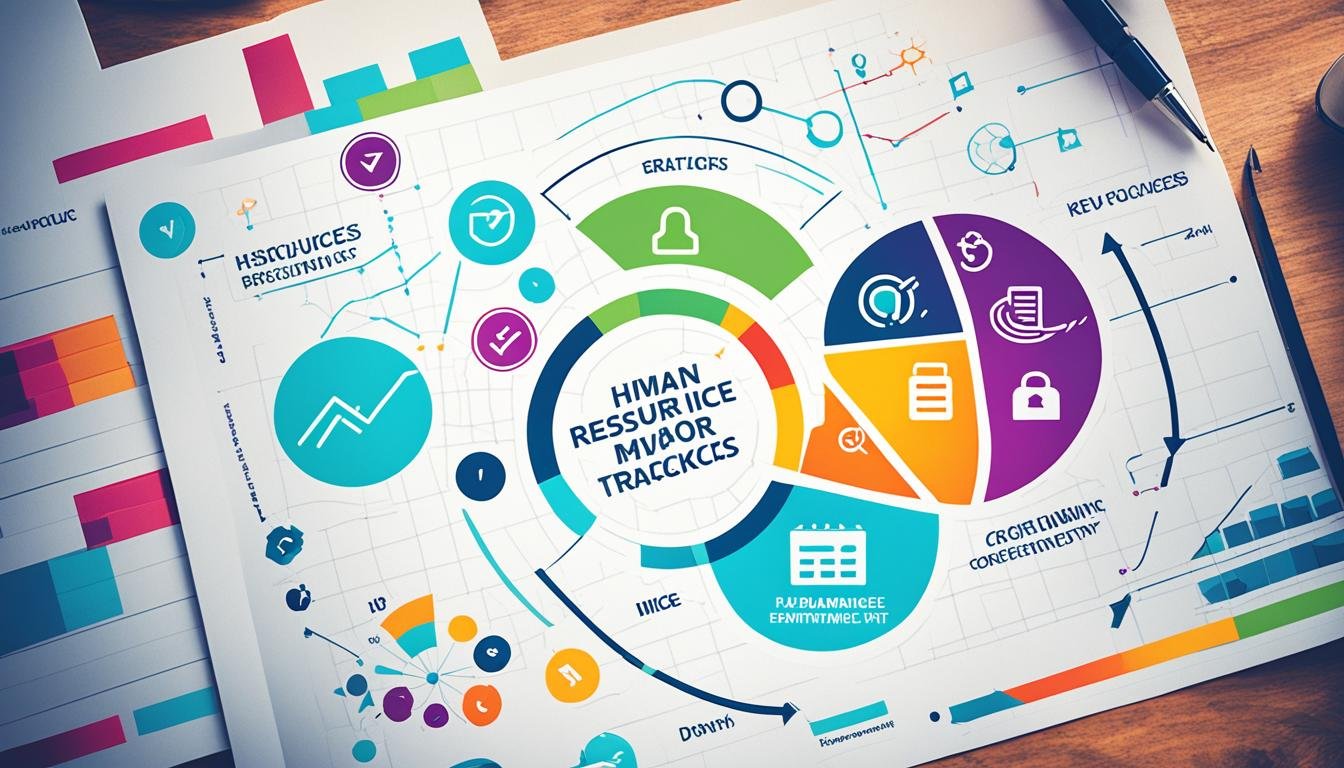A Guide to Human Resources Management Metrics
Human resource metrics, also known as HR metrics, are crucial for organizations to track and measure the effectiveness of their human resources initiatives. Companies are increasingly recognizing the importance of people data and analytics, with 82% of executives agreeing that HR metrics are useful for their organization. This article will provide an in-depth guide to 29 essential HR metrics that organizations can start measuring today.
HR metrics help organizations gain insights into their workforce, make data-driven decisions, and improve overall HR performance. By analyzing HR data, organizations can identify areas for improvement, measure the impact of HR initiatives, and align HR strategies with organizational goals. Additionally, HR metrics enable HR professionals to demonstrate the value and impact of their work to key stakeholders.
From recruitment and employee engagement to training and development, HR metrics cover a wide range of areas. Whether it’s measuring cost per hire, employee turnover rate, or training effectiveness, these metrics provide valuable information for optimizing HR processes and driving strategic business growth.
In the ever-evolving business landscape, where talent acquisition and retention are critical, HR metrics play a vital role in shaping effective workforce management strategies. By leveraging HR analytics tools and reporting technologies, organizations can effectively measure HR performance, identify trends, and make informed decisions that drive success.
Now, let’s dive deeper into the world of HR metrics and discover how they can revolutionize your human resources management practices.
Key Takeaways:
- HR metrics are crucial for tracking and measuring the effectiveness of HR initiatives.
- 82% of executives agree that HR metrics are useful for their organization.
- HR metrics enable organizations to make data-driven decisions and optimize HR processes.
- There are 29 essential HR metrics that organizations can start measuring today.
- HR analytics tools and reporting technologies help organizations gain insights into workforce management and drive strategic business growth.
Understanding HR Metrics and Establishing HR KPIs
HR metrics, or human resource metrics, are essential data points that enable organizations to track their human capital and measure the effectiveness of their HR initiatives. By measuring HR metrics, organizations can gain valuable insights into what is working well, identify areas for improvement, and anticipate future trends. Establishing HR Key Performance Indicators (KPIs) plays a crucial role in aligning these metrics with the organization’s overall strategy, ensuring that HR efforts are in line with the company’s objectives.
“Measuring HR and its impact on the organization is critical,” emphasizes a recent study conducted with both executives and HR professionals. It underscores the significance of HR metrics and their role in driving organizational success.
HR metrics provide a comprehensive view of various aspects of the HR function, ranging from workforce management to employee engagement and organizational growth. These metrics enable HR teams to assess the effectiveness of their strategies, programs, and initiatives, empowering them to make data-driven decisions for continuous improvement.
Why HR metrics matter
- They help organizations evaluate the success of their HR initiatives and identify areas for improvement.
- They provide insights into workforce trends, enabling organizations to anticipate future talent needs.
- They align HR efforts with organizational strategy, driving overall business success.
- They enable HR teams to measure employee engagement, satisfaction, and retention, leading to a more productive and satisfied workforce.
Some common HR metrics and their significance
| HR Metric | Significance |
|---|---|
| Employee Turnover Rate | Measures the rate at which employees are leaving the organization, providing insights into retention efforts and overall employee satisfaction. |
| Time-to-Fill | Measures the time taken to fill open positions, indicating the efficiency of the recruitment process and the organization’s ability to attract top talent. |
| Training Return on Investment (ROI) | Evaluates the effectiveness and value of training programs in terms of the impact on employee performance and organizational outcomes. |
| Employee Engagement Score | Measures the level of employee engagement and satisfaction with their work, providing insights into organizational culture and leadership effectiveness. |
Note: The above table presents just a few examples of HR metrics. Organizations should identify and track metrics that align with their specific goals and objectives.
Importance of HR Reports for Strategic Decision Making
HR reports play a crucial role in strategic decision making for organizations. While many HR professionals acknowledge the importance of HR metrics, there is often a lack of regular reporting to the executive teams. This gap presents an opportunity for HR teams to collaborate with executives to understand their reporting needs and provide them with the necessary HR metrics.
HR reports should include metrics related to employee satisfaction and employee engagement, as these factors are key indicators of HR success and their impact on the overall organization. By including these metrics, executives can gain deeper insights into the effectiveness of HR initiatives and make data-driven decisions that align with the organization’s strategic goals.
“Regular and comprehensive HR reports are invaluable tools for executive teams, providing them with the necessary information to make well-informed strategic decisions. By including employee satisfaction and engagement metrics, HR reports enable executives to understand the impact of HR initiatives on employee well-being and overall organizational performance.”
When HR teams collaborate with executives and provide meaningful HR reports, it creates a stronger alignment between HR initiatives and the organization’s strategic objectives. This alignment enables proactive decision making and the implementation of effective strategies to enhance employee satisfaction, engagement, and productivity.
Moreover, HR reports allow executives to identify trends and patterns in employee data. These insights can help drive transformational change, optimize workforce planning, and address potential challenges or gaps in HR programs. By leveraging HR reports, organizations can foster a culture of continuous improvement and ensure that HR initiatives are aligned with the ever-evolving needs of the business.
Key Benefits of HR Reports for Strategic Decision Making:
- Provide data-driven insights into HR initiatives
- Enable alignment between HR and organizational objectives
- Highlight employee satisfaction and engagement metrics
- Identify trends and patterns in employee data
- Facilitate proactive decision making and strategic planning
By recognizing the importance of HR reports in strategic decision making and leveraging the insights they provide, organizations can drive positive change, optimize HR initiatives, and ultimately achieve strategic business success.
| HR Report Metrics | Description |
|---|---|
| Employee Satisfaction | Measures the level of employee contentment and happiness within the organization. |
| Employee Engagement | Evaluates the degree to which employees are committed to their work and the organization. |
| Turnover Rate | Calculates the percentage of employees who leave the organization within a given time period. |
| Training and Development ROI | Assesses the return on investment for training and development programs. |
| Performance Metrics | Measures individual and team performance against defined goals and objectives. |
Essential HR Service and Software Metrics
HR service and software metrics are crucial for organizations to measure the effectiveness and efficiency of their HR functions. By tracking these metrics, companies can make data-driven decisions, optimize processes, and drive improvements in employee satisfaction, engagement, and overall performance. Let’s explore some of the key metrics that organizations should consider:
1. Cost of HR per Employee
The cost of HR per employee is an important metric that helps organizations understand their HR expenditure. It measures the total cost of HR activities divided by the number of employees. This metric provides insights into the financial resources allocated to HR functions and allows organizations to assess the efficiency of their HR operations.
2. HR Software Employee Participation Rate
The HR software employee participation rate measures the engagement and adoption of HR software among employees. It calculates the percentage of employees actively using HR software tools and platforms. A higher participation rate indicates better employee engagement and utilization of HR software resources, leading to increased efficiency and productivity.
3. Ratio of HR Professionals to Employees
The ratio of HR professionals to employees is a metric that provides insights into the capacity and workload of the HR department. It measures the number of HR professionals relative to the total number of employees. By analyzing this ratio, organizations can determine if their HR team is adequately staffed to handle the HR needs of the workforce or if additional resources are required.
4. ROI of HR Software
The ROI of HR software measures the cost-effectiveness and value generated by investments in HR software. It compares the financial benefits gained from using HR software, such as increased efficiency and reduced administrative costs, to the initial investment. A positive ROI indicates that the HR software is delivering value to the organization.
| Metric | Description |
|---|---|
| Cost of HR per Employee | Measures the total cost of HR activities divided by the number of employees. |
| HR Software Employee Participation Rate | Calculates the percentage of employees actively using HR software tools and platforms. |
| Ratio of HR Professionals to Employees | Measures the number of HR professionals relative to the total number of employees. |
| ROI of HR Software | Compares the financial benefits gained from using HR software to the initial investment. |
These HR service and software metrics provide valuable insights into the effectiveness of HR functions, the engagement of employees with HR software, the workload of the HR team, and the return on investment from HR software. By regularly measuring and analyzing these metrics, organizations can optimize their HR operations, enhance employee experiences, and drive sustainable business growth.
Key Recruitment Metrics for Hiring Success
For organizations, optimizing the hiring process and ensuring successful talent acquisition are crucial goals. To achieve these objectives, it is essential to track and analyze recruitment metrics that provide insights into the effectiveness and efficiency of the recruitment process. This section explores key recruitment metrics that organizations should focus on to drive hiring success.
Acceptance Rate
The acceptance rate metric measures the percentage of offers extended to candidates that are accepted. A high acceptance rate indicates a successful recruitment process, indicating that the organization is attracting and selecting candidates who align with their expectations and requirements. On the other hand, a low acceptance rate may signal potential issues in the recruitment process or misalignment between the organization and candidates.
Cost per Hire
The cost per hire metric quantifies the monetary investment required to hire a new employee. It includes expenses related to sourcing, interviewing, background checks, and onboarding. Analyzing the cost per hire helps organizations evaluate the efficiency of their recruitment strategies and identify areas where cost optimization is possible.
Demographics
Demographic metrics provide insights into the composition of the workforce, such as age, gender, ethnicity, and educational background. Understanding the demographics of the organization’s talent pool helps in evaluating diversity and inclusion efforts, ensuring fair representation, and identifying any potential biases in the recruitment process.
Headcount
The headcount metric refers to the total number of employees within the organization. Tracking headcount allows organizations to monitor workforce growth and plan for future hiring needs. It also provides a basis for understanding the overall impact of recruitment efforts on the organization’s size and structure.
New-Hire Turnover
New-hire turnover measures the rate at which newly hired employees leave the organization within a specified period, typically the first year. High new-hire turnover can indicate issues with the onboarding process, training programs, or cultural fit. This metric helps organizations identify opportunities for improvement in ensuring the retention and long-term success of new hires.
Time to Hire
Time to hire measures the number of days it takes to fill a job opening from the moment it is posted until the candidate is hired. Analyzing time to hire provides insights into the efficiency of the recruitment process, helping organizations identify bottlenecks and streamline their hiring workflows.
Time to Productivity
Time to productivity measures the duration it takes for new hires to reach their full potential and contribute effectively to the organization. Tracking time to productivity helps organizations assess the effectiveness of their onboarding and training programs, identify areas for improvement, and ensure that new hires are integrated efficiently into their roles.
By monitoring and analyzing these recruitment metrics, organizations can make data-driven decisions to optimize their hiring processes, enhance candidate experiences, and ensure the successful acquisition of top talent.
Employee Engagement and Retention Metrics
Employee engagement and retention metrics are essential for organizations to measure and improve employee satisfaction, engagement, and overall retention rates. These metrics provide valuable insights into the effectiveness of HR initiatives and help organizations identify areas for improvement.
Employee Satisfaction
Employee satisfaction is a key metric that measures how happy and content employees are in their roles. It can be measured through surveys, feedback sessions, or employee satisfaction scores. By tracking employee satisfaction, organizations can gauge the overall level of employee happiness and identify any factors that may be negatively impacting engagement and retention.
Retention Rate
The retention rate is the percentage of employees who remain with an organization over a given period. A high retention rate indicates that employees are satisfied and engaged, while a low rate may highlight issues that need to be addressed. Regularly tracking and analyzing the retention rate can help organizations identify trends, such as departments or positions with high turnover, and develop targeted strategies to improve retention.
Talent Turnover Rate
The talent turnover rate measures the rate at which employees with high potential or critical skills leave the organization. By focusing on talent turnover, organizations can identify areas where they may be losing top performers and take proactive steps to retain them. Implementing targeted development programs and recognition initiatives can help organizations reduce talent turnover and retain their most valuable employees.
Total Turnover Rate
The total turnover rate measures the overall percentage of employees who leave an organization within a given period, including voluntary and involuntary separations. Tracking the total turnover rate provides a comprehensive view of employee attrition and can help organizations understand the impact of turnover on their workforce. Analyzing the reasons behind turnover can help organizations identify areas for improvement and implement strategies to increase retention.
Voluntary Turnover Rate
The voluntary turnover rate measures the percentage of employees who choose to leave the organization. This metric specifically focuses on employees who resign or choose not to renew their employment contracts. High voluntary turnover rates can indicate underlying issues such as poor management, lack of growth opportunities, or a negative work culture. By tracking this metric, organizations can identify patterns and take action to improve retention and engagement.
Performance Management Metrics for Assessing Employee Performance
Performance management metrics are invaluable tools for organizations to assess and improve employee performance. By utilizing key metrics, organizations gain valuable insights into individual and company-wide performance, enabling them to set goals, align performance with company objectives, and evaluate the impact of employee contributions on overall company success.
One essential performance management metric is company performance. This metric measures the overall success and financial health of the organization. It provides organizations with a holistic view of their performance and serves as a benchmark for evaluating employee contributions.
Employee performance metric focuses on evaluating the individual performance of employees. It enables organizations to measure employee productivity, quality of work, and their ability to meet performance expectations.
Goal tracking is another vital metric that helps organizations monitor progress towards achieving specific objectives. By tracking goals, organizations can identify areas of improvement, recognize top performers, and ensure alignment with strategic priorities.
Assessing performance and potential is crucial for identifying high-performing employees who possess the capabilities and potential for growth and development within the organization. By evaluating both current performance and future potential, organizations can identify and nurture talent for key positions.
Revenue per employee metric provides insights into the productivity and effectiveness of the workforce. It calculates the amount of revenue generated per employee, indicating the efficiency of the organization’s human capital and its ability to generate value.
Effective performance management metrics allow organizations to measure, analyze, and improve employee performance, leading to enhanced productivity, engagement, and overall business success.
To illustrate the importance of performance management metrics, the following table showcases a sample of key metrics and their significance:
| Metric | Significance |
|---|---|
| Company Performance | Evaluates overall organizational success and financial health. |
| Employee Performance | Measures individual productivity and quality of work. |
| Goal Tracking | Monitors progress towards achieving specific objectives. |
| Performance and Potential | Assesses both current performance and future growth potential. |
| Revenue per Employee | Measures workforce productivity and value generation. |
Training and Development Metrics for Employee Growth
Training and development are vital for nurturing employee skills and driving organizational growth. Effective training programs require constant evaluation and measurement to ensure that they contribute to employee development and overall success. By utilizing training and development metrics, organizations can assess the effectiveness of their training initiatives, improve employee engagement, and optimize their learning programs.
Here are some key metrics that organizations should consider when evaluating their training and development programs:
- Training Completion Rate: This metric measures the percentage of employees who successfully complete the training program. It helps gauge the level of engagement and commitment to training within the organization, providing insights into the effectiveness of the program.
- Time to Completion: Tracking the time it takes for employees to complete the training program is essential. This metric ensures that the training is well-paced and aligned with employees’ learning abilities, preventing unnecessary delays and optimizing the use of resources.
- Training Effectiveness: This metric focuses on the impact of training on employee performance. It assesses whether the training program has improved employees’ skills, knowledge, and job performance. Collecting feedback from participants and supervisors can provide valuable insights into the effectiveness of the training.
- Training Expenses per Employee: Understanding the cost-effectiveness of training programs is crucial for budget allocation and resource optimization. This metric calculates the average training expenses incurred per employee, including costs for materials, trainers, and technology.
By analyzing these metrics, organizations can identify areas of improvement and optimize their training and development initiatives to nurture employee growth and enhance organizational performance.
HR Analytics Tools for Data-Driven Decision Making
HR analytics tools are essential for organizations seeking to make data-driven decisions. These tools enable the collection and analysis of people data, facilitate the generation of HR reports, and provide valuable insights into workforce analytics. With the help of HR software, such as BambooHR, HR departments can streamline the reporting process, making it easier to collect and analyze data efficiently.
By leveraging HR analytics tools, organizations can make informed decisions based on accurate data. These tools enable the identification of trends and patterns within the workforce, helping organizations develop effective strategies for talent management and business growth.
One example of an HR analytics tool is BambooHR, which offers a range of features designed to simplify and enhance HR reporting. Through its intuitive interface, BambooHR allows HR professionals to generate comprehensive reports and visualize key HR metrics. The platform enables the analysis of data related to employee performance, turnover rates, and workforce demographics, among others.
Additionally, HR analytics tools enable data-driven decision making by providing insights into employee engagement, productivity, and performance. By analyzing this data, organizations can identify areas of improvement and implement targeted strategies to enhance employee satisfaction and engagement.
Furthermore, HR analytics tools aid in workforce planning and forecasting. By understanding the current state of the workforce and analyzing historical data, organizations can make informed decisions regarding talent acquisition, development, and succession planning.
In summary, HR analytics tools empower organizations to make data-driven decisions based on accurate and comprehensive people data. These tools, such as BambooHR, streamline the reporting process and provide valuable insights into workforce analytics, enabling organizations to develop effective strategies for talent management and drive business growth.
| Benefits of HR Analytics Tools | Examples of HR Analytics Tools |
|---|---|
|
|
Conclusion
Human Resources Management Metrics, also known as HR metrics, are essential for effective workforce management and strategic business growth. By tracking key HR metrics, organizations can measure the impact of their HR initiatives, make data-driven decisions, and drive improvements in employee satisfaction, engagement, and retention.
Implementing HR analytics tools and software enables organizations to collect, analyze, and report on HR data, providing valuable insights for strategic planning and decision making. With a comprehensive understanding of HR metrics, organizations can optimize their human resource strategies and drive success in today’s competitive business landscape.
By leveraging HR metrics and analytics, organizations can identify trends, address challenges, and proactively plan for the future. Through workforce management strategies informed by HR analytics, businesses can effectively allocate resources, maximize employee performance, and foster a culture of continuous improvement.
As the HR landscape continues to evolve, it is crucial for organizations to embrace HR metrics and analytics as a key driver of strategic business growth. With the right HR metrics and analytics tools in place, organizations can make informed decisions, enhance their workforce management practices, and thrive in an ever-changing business environment.







